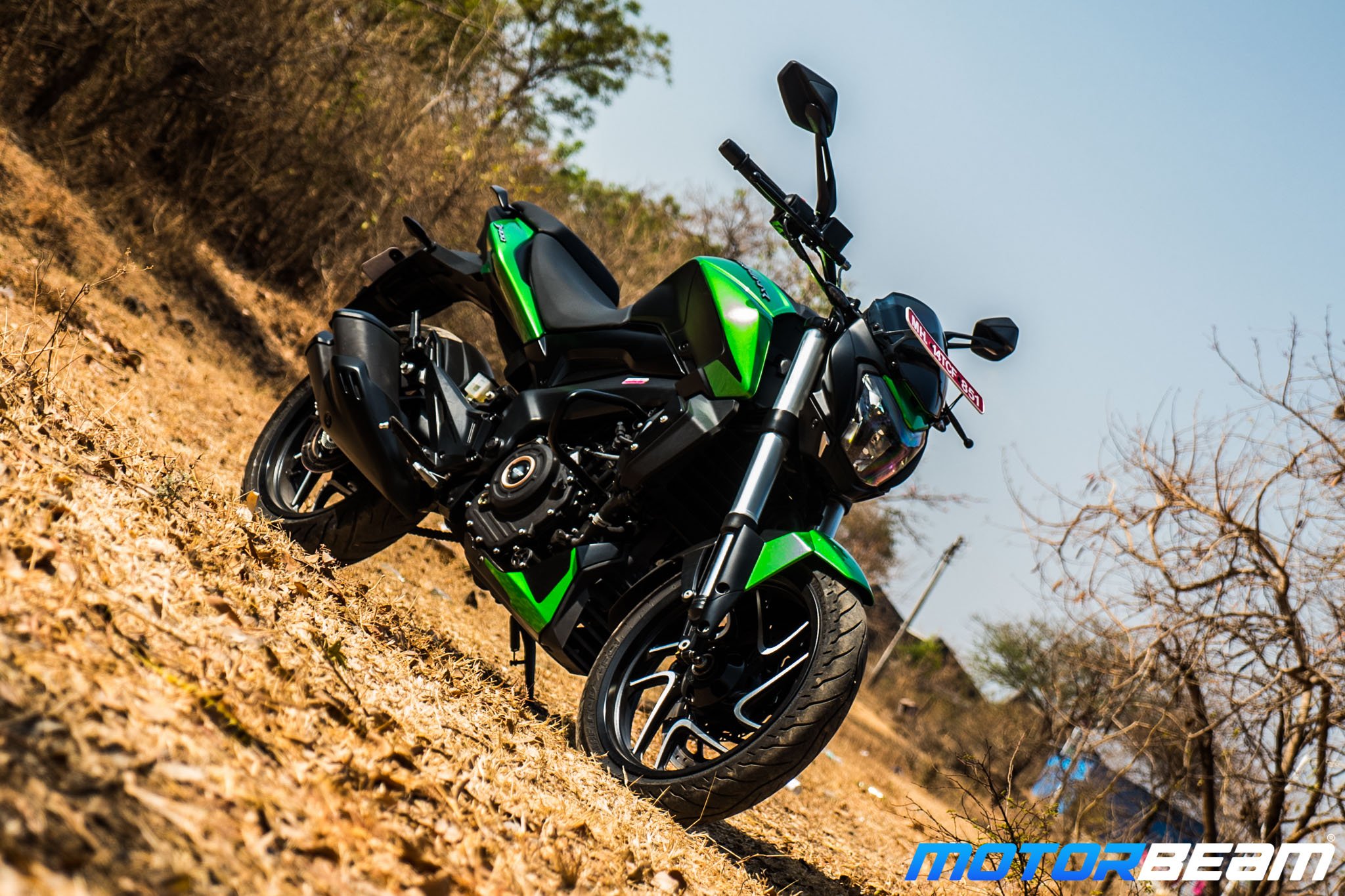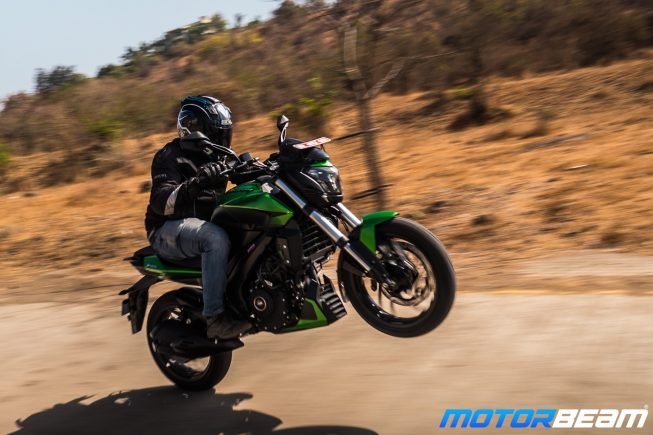
2019 Bajaj Dominar 400 Review
Bike Tested: 2019 Bajaj Dominar 400; Road Test No. 1070; Test Location: Pune
Price OTR Mumbai: Rs. 2,20,495 /- (Estimated)
With this update, the Bajaj Dominar 400 gets even better!
Bajaj had started the testing of the Dominar 400 quite early and we were lucky to get a first ride experience of the bike back in Mahabaleshwar. The overall experience of the bike was pretty good, except for some shortcomings that we faced. We also raced the bike against India’s fastest train, the Rajdhani, in which the Dominar 400 came out as a winner. There were still some bits and pieces where the Dominar lagged behind, but with an update, it got better. Visually, after the minor update, the bike got some catchy golden rims and new paint schemes. Now, the Dominar has got an upgrade per se. The latest Dominar 400 UG is loaded with new hardware and has got a handsome cosmetic update. Let’s find out what makes the new 2019 Bajaj Dominar 400 UG better than its rivals.
Motor Quest: The Bajaj Dominar was launched in 2016 and the first ride review happened in January 2017. A mid-way update introduced new colours and golden rims while there were no mechanical changes. In 2019, Bajaj has upgraded the Dominar 400 significantly and introduced mechanical as well as cosmetic changes.
The 2019 Dominar 400 gets a bolder and meaner look
Styling – The Dominar 400 hasn’t changed much when you skim over the surface, but when you get down and dirty with the bike, there are a whole lot of changes that have been made to the bike. Starting with the headlights, it retains the same 10 LED headlight setup that illuminates the roads at night, but it is now shorter and smaller in size, with the plastic panels embedding the LED housing which has led to an improved focal area of the headlights. The tank used to sport the body colour completely in the previous versions, but now it features a matte black colour on the sides that goes along with the contours of the bike.
The “Auroral” green colour looks quite exquisite
The pillion seat has a sporty D logo embossed on it which makes it a bit of an eye pleaser. The mirrors have also been updated, which now are made of aluminium cast, making it ergonomic and lightweight, with a snazzy look to it. The grab rails remain identical to the previous versions, but the LED taillights have been updated, giving it a more premium look. USD forks have replaced the conventional telescopic forks up front, providing a more premium look to the bike and also improving the handling. The company has shifted back to black and silver alloy wheels. The exhaust is now a dual-barrel setup, that gives a throaty note to the bike.
Primary digital console looks exactly the same as before
Instrument Cluster and Switchgear – Bajaj has kept the primary instrument cluster, placed on the handlebar, the same. Whereas, the instrument cluster on the tank that had telltale lights previously, now features a small dot matrix cluster. It gets displays like gear position indicator, clock, trip meter and odometer. However, it causes a bit of an inconvenience as one cannot see these functions when they are riding due to the fact that it is situated too low.
Secondary console is now digital and has more information on offer
The telltale lights that were present earlier have been removed and reduced and now feature into the primary cluster. The Bajaj logo has also been removed from the cluster. The primary unit still retains the same tachometer, speedometer and fuel gauge, but has an addition of live fuel mileage, side stand indicator, fuel mileage of both the trip meters and odometer reading. The switchgear quality has been maintained as well and the buttons still have a backlight and come in piano black finish.
Ergonomics and riding haven’t been altered, they are exactly the same
Ergonomics – The ergonomics stay exactly the same between the old and the new version of the Dominar 400. There is a slight change when you look at the traffic behind you as the new mirrors have a better view of what’s behind. The handlebar, seat height and pillion seating position remain the same and retain the same comfort levels. The seating posture is still upright, with centre set foot pegs that provide a comfortable riding position for touring. The seat for the pillion still remains quite slim, making it a task to find a comfortable spot to sit on. The handlebar weights are now wider and heavier aiding to slightly better ergonomics.
The motor has an even better punch, it effortlessly lifts a wheel
Performance – There is a huge difference in terms of power between the older and the newer versions of the bike. The engine gets a 5 PS bump in power, thanks to the DOHC, engine mapping and the new double-barrel exhaust setup. The compression ratio is now increased for more power, making the engine feel pretty lively. It has a very strong mid-range and a good low-end too. The bike still redlines at 9500 RPM, which is not much, but still pulls very well. The bike reaches 100 km/hr in 7.1 seconds which is almost a second faster than the previous model. The VBOX tested top speed has also increased by 8 km/hr which now comes to 156 km/hr. The gearing and the clutch feel remains the same, but the update in the top speed means that you can go faster. Bajaj has also increased the power-to-weight ratio of the bike to 217.4 PS/ton, making it a tad bit sportier.
The motor feels quite refined compared the previous version
The exhaust note is bassy at idle while it gets louder and better as you rev hard
Cruising at 100 km/hr has become a lot smoother and enjoyable as the throttle response has improved a lot. If you feel like stretching your legs, you can do it without breaking a sweat on the bike as it now accelerates pretty quickly. The vibrations have reduced drastically and there is almost nowhere that you can sense it. Although there is a slight buzz at the footpegs and the seat, vibrations only come into the picture when you are closing in on the rev limit. The exhaust now has a very throaty and louder note to it, the throaty note continues till the rev limit, making it enjoyable to ride.
The Dominar 400 tips into corners very well
Riding Dynamics – Riding dynamics are now much better due to a heavier front end thanks to the USD forks, the overall weight has also increased, but to tackle that, there is that more powerful engine, which doesn’t let it feel dull. The bike dips into corners pretty nicely with nice cornering stability and holds the line pretty well. The front suspension has a better feel to it through the handlebar. The preload adjustable monoshock at the back is softened up a bit and feels a bit weighty when you have a pillion or some luggage at the back, but is more comfortable than the KTM Duke series. The USD forks have been borrowed from the KTM Duke, which is a bit harder now when compared to the previous telescopic version. Whereas, at the rear, the spring index has been changed, making it softer.
Straight line stability is brilliant, stays surefooted
Tips into corners well and holds the line too, suspension setup is now more compliant to touring duties
The braking has improved a bit because the front disc now gets a radial caliper and has a nice bite to it. The disc size remains the same, but with better stopping power. The dual-channel ABS unit is still on offer and is a non-switchable one. The MRF tyres that were also offered previously don’t grip that well. Now that there is a bump in power, you can feel that the tyres don’t provide that assurance of sticking to the road. The bike tends to lose grip under heavy acceleration and also when you hit the brakes too hard.
The bike has become even more nimble than before, feels very well put together
Verdict – The Dominar 400 now looks considerably fresh, with a new catchy “Auroral” green paint scheme and blacked outside profile of the tank. It still is an all-rounder motorcycle which can be used for the daily commute and can be taken on long distance rides. The Dominar 400 is now much more powerful, with the top speed crossing the 160 km/hr mark. The bike is also a lot smoother and touring capabilities have improved too. Although there are a few drawbacks, like the MRF tyres that are not up to the mark, the absence of a ride-by-wire feature, it is still a very appealing package. As it is now a pure sport-tourer by Bajaj we could even see some touring accessories coming by officially.
Personally, the taillight just steals the show!
What’s Cool
* The USD forks and a slew of changes give it a fresh look
* The suspension setup is more comfortable yet sharp, handle better
* Vibrations from the engine have reduced drastically while the engine produces more power
What’s Not So Cool
* The pillion seat is still a bit too narrow for a comfortable ride
* The green colour looks good in person but has a Kawasaki feel to it
* Braking performance isn’t up to the mark, MRF tyres don’t do justice here
This POV is quite appealing now
Bajaj Dominar 400 Specifications
* Engine: 373.2cc, liquid cooled, DOHC
* Power: 40 PS @ 8650 RPM
* Torque: 35 Nm @ 7000 RPM
* Transmission: 6-Speed With Slipper Clutch
* Fuel Type: Petrol
* Fuel Consumption: 27 km/l
* Frame: Perimeter frame
* Tyres: 110/70/17 (Front), 150/60/17 (Rear), MRF Zapper
* Suspension: 43 mm USD forks (Front), Nitrox Monoshock (Rear)
* Brakes: 320 mm Disc (Front), 230 mm Disc (Rear), Dual-Channel ABS
Bajaj Dominar 400 Dimensions
* Length x Width x Height: 2156 mm x 836 mm x 1112 mm
* Wheelbase: 1453 mm
* Seat Height: 800 mm
* Ground Clearance: 157 mm
* Fuel Tank Capacity: 13-litres
* Kerb weight: 184 kgs
Further Reading –
2019 Dominar 400 Video Review
2017 Dominar 400 Video Review
Dominar 400 Long Term Review – First Report
[wp-review id=”231911″]





